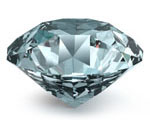| |
|
 |
 |
Carat is the unit weight measurement used to define the size of gemstones, including diamonds. One carat is equal to 200 milligrams, or 0.2 grams. In jewelry pieces with more than one diamond, the carats may be described in terms of total carat weight. This is the combined total weight of all the stones in the piece. different gems of the same weight aren't necessarily the same size, because some gemstones are more dense than others.
|
 |
|
|
|
 |
|
 |
 |
The clarity of a diamond is an important factor in determining its value. Virtually all diamonds have internal blemishes, commonly known as inclusions or surface irregularities. Clarity gradings are determined by the amount, severity, and location of the inclusions. Diamonds are generally evaluated under 10X magnification using sophisticated microscopes to locate inclusions which may not be visible to the naked eye. The following clarity grading standards are used by GEMOLOGIC for diamonds:
|
 |
|
Flawless (FL) |
No inclusions or blemishes under 10X magnification when inspected by an experienced evaluator. |
Internally Flawless (IF) |
No internal inclusions and only very minor surface blemishes under 10X magnification. |
Very Very Slightly Included (VVS) |
Two grading categories, namely VVS1 and VVS2. Inclusions such as pinpoints, faint clouds, feathers or internal graining that are extremely difficult to see with the naked eye. |
Very Slightly Included (VS) |
Two grading categories, namely VS1 and VS2. Minor inclusions such as pinpoints, faint clouds, feathers or internal graining that are difficult to see with the naked eye. |
Slightly Included (SI) |
Three grading categories, namely SI1, SI2 and SI3. Inclusions may be visible to the naked eye under close examination but may not be visible when the Diamond is mounted. |
Imperfect (I) |
Three grading categories, namely I1, I2 and I3. Inclusions are usually visible to the naked eye. |
|
 |
The clarity of a gemstone is an important factor in determining its value. Virtually all gemstones have internal blemishes, commonly known as inclusions or surface irregularities. Clarity gradings are determined by the amount and severity of the inclusions. Gemstones are generally evaluated under 10X magnification using sophisticated microscopes to locate inclusions which may not be visible to the naked eye. The following clarity grading standards are used by GEMOLOGIC for gemstones:
|
Extra Fine |
The stone appears clean to the naked eye. |
Fine |
Minute inclusions difficult to see with the naked eye. |
Good |
Minor inclusions somewhat easy to see with the naked eye. |
Fair |
Inclusions are visible to the naked eye. |
Poor |
Inclusions are prominent and have a negative effect on the appearance or durability. |
|
 |
 |
Diamond color is a key parameter in determining its value as well as its beauty. The diamond color scale starts from D to Z. Diamonds with no color like D, E, F, are very rare and are more expensive than near-colorless (G, H, I, J) diamonds.
The following color grading standards are used by GEMOLOGIC for diamonds: |

|
 |
Extra Fine |
Color near perfectly distributed with vivid saturation. |
Fine |
Color is evenly distributed with slight deviations, and minor areas where color slightly darkens or lightens. |
Good |
Color is mostly evenly distributed with deviations and areas where color slightly darkens or lightens. |
Fair |
Color is mostly even with heavier variations of lighter and darker tones, and some grayish or brownish saturation may be noticeable. |
Poor |
Color is undesirable with wide variations, heavy zoning, and visible grayish and brownish saturation. |
|
|
|
|
Copyright © 2007 GEMOLOGIC Inc. |
|
| |